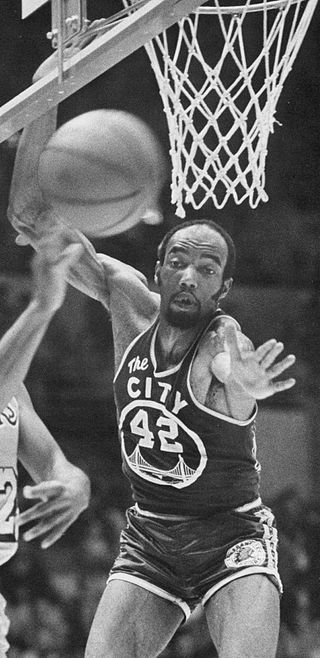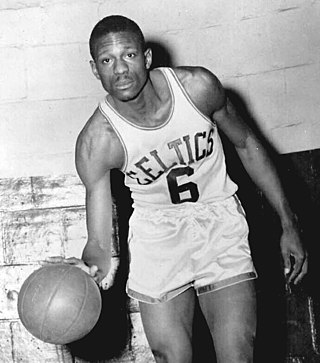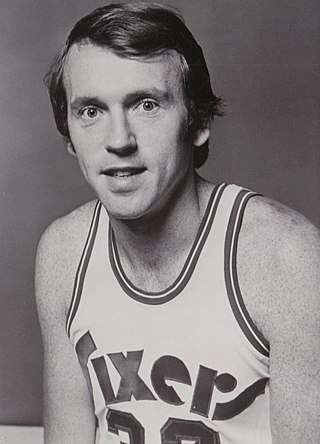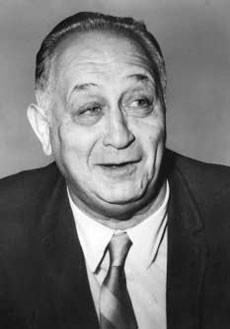
The Golden State Warriors are an American professional basketball team based in San Francisco. The Warriors compete in the National Basketball Association (NBA) as a member of the Pacific Division of the Western Conference. Founded in 1946 in Philadelphia, the Warriors moved to the San Francisco Bay Area in 1962 and took the city's name before changing its geographic moniker to Golden State in 1971. The club plays its home games at Chase Center.

Wilton Norman Chamberlain was an American professional basketball player. Standing 7 ft 1 in (2.16 m) tall, he played center in the National Basketball Association (NBA) for 14 seasons. Widely regarded as one of the greatest basketball players of all time, Chamberlain was enshrined in the Naismith Memorial Basketball Hall of Fame in 1978 and elected to the NBA's 35th, 50th, and 75th anniversary teams. Following his professional basketball career, Chamberlain played volleyball in the short-lived International Volleyball Association (IVA). He served one term as league president and is enshrined in the IVA Hall of Fame. Renowned for his strength, he played the antagonist in the 1984 Arnold Schwarzenegger film Conan the Destroyer.

Nathaniel Thurmond was an American basketball player who spent the majority of his 14-year career in the National Basketball Association (NBA) with the Golden State Warriors franchise. He played the center and power forward positions. Thurmond was a seven-time All-Star and the first player in NBA history to record an official quadruple-double. In 1965, he grabbed 42 rebounds in a game; only Wilt Chamberlain and Bill Russell recorded more rebounds in an NBA game. Thurmond was named a member of the Naismith Memorial Basketball Hall of Fame in 1985, one of the 50 Greatest Players in NBA History, and part of the NBA 75th Anniversary Team in 2021.

Paul Joseph Arizin, nicknamed "'Pitchin Paul", was an American basketball player who spent his entire National Basketball Association (NBA) career with the Philadelphia Warriors from 1950 to 1962. He retired with the third highest career point total (16,266) in NBA history, and was named to the NBA's 25th, 50th and 75th anniversary teams. He was a high-scoring forward at Villanova University before being drafted by the Warriors of the fledgling NBA.

Thomas Joseph Gola was an American basketball player and politician. He is widely considered one of the greatest NCAA basketball players of all time. Gola was inducted into the Naismith Memorial Basketball Hall of Fame in 1976.

William Felton Russell was an American professional basketball player who played center for the Boston Celtics of the National Basketball Association (NBA) from 1956 to 1969. He was the centerpiece of the Celtics dynasty that won 11 NBA championships during his 13-year career. Russell is widely considered to be one of the greatest basketball players of all time.

Westley Sissel Unseld Sr. was an American professional basketball player, coach and executive. He spent his entire National Basketball Association (NBA) career with the Baltimore/Capital/Washington Bullets. Unseld played college basketball for the Louisville Cardinals and was selected with the second overall pick by the Bullets in the 1968 NBA draft. He was named the NBA Most Valuable Player and NBA Rookie of the Year during his rookie season and joined Wilt Chamberlain as the only two players in NBA history to accomplish the feat. Unseld won an NBA championship with the Bullets in 1978, and the Finals MVP award to go with it. After retiring from playing in 1981, he worked with the Bullets/Wizards as a vice president, head coach, and general manager.
The 50 Greatest Players in NBA History, also referred to as NBA's 50th Anniversary All-Time Team, were chosen in 1996 to honor the 50th anniversary of the founding of the National Basketball Association (NBA). It was the third anniversary team in the league. Fifty players were selected through a vote by a panel of media members, former players and coaches, and current and former general managers. In addition, the top ten head coaches and top ten single-season teams in NBA history were selected by media members as part of the celebration. The 50 players had to have played at least a portion of their careers in the NBA and were selected irrespective of position played.

Alexander Murray Hannum was a professional basketball player and coach. Hannum coached two National Basketball Association (NBA) teams and one American Basketball Association (ABA) team to league championships. He had a combined NBA-ABA record of 649–564 (.535) in the regular season and 61–46 (.570) in the playoffs over 16 seasons. In 1998, he was inducted into the Naismith Memorial Basketball Hall of Fame as a coach.

William John Cunningham is an American former professional basketball player and coach, who was nicknamed the Kangaroo Kid for his leaping and record-setting rebounding abilities. He spent a total of 17 seasons with the NBA's Philadelphia 76ers, and two seasons as a player with the Carolina Cougars of the ABA.

Guy William Rodgers was an American professional basketball player born in Philadelphia. He spent twelve years (1958–1970) in the NBA, and was one of the league's best playmakers in the early to mid-1960s. Rodgers led the NBA in assists twice, and placed second six times. Rodgers was inducted into Naismith Memorial Basketball Hall of Fame in 2014.

William Walton Sharman was an American professional basketball player and coach. He is mostly known for his time with the Boston Celtics in the 1950s, partnering with Bob Cousy in what was then considered the greatest backcourt duo of all time. As a coach, Sharman won titles in the ABL, ABA, and NBA, and is credited with introducing the now-ubiquitous morning shootaround.
Donald Neil Johnston was an American basketball player and coach. A center, Johnston played in the National Basketball Association (NBA) from 1951 to 1959. He was a member of the Philadelphia Warriors for his entire career. Known for his hook shot, Johnston was a six-time NBA All-Star; he led the NBA in scoring three times and led the league in rebounding once. He won an NBA championship with the Warriors in 1956. After his playing career ended due to a knee injury, Johnston coached in the NBA, in other professional basketball leagues, and at the collegiate level. He was inducted into the Naismith Memorial Basketball Hall of Fame as a player in 1990.

John Raymond Scott is an American former professional basketball player and coach. He was the first African American NBA coach to win the coach of the year award.

Edward Gottlieb was a Jewish-Ukrainian professional basketball coach and executive. Nicknamed "Mr. Basketball" and "The Mogul", he was the first coach and manager of the Philadelphia Warriors of the National Basketball Association (NBA), and later became the owner of the team from 1951 to 1962. A native of Kiev, Ukraine, he was elected to the Naismith Memorial Basketball Hall of Fame as a contributor on April 20, 1972. The NBA Rookie of the Year Award, the Eddie Gottlieb Trophy, was formerly named after him.
The 1959 NBA draft was the 13th annual draft of the National Basketball Association (NBA). The draft was held on March 31, 1959, before the 1959–60 season. In this draft, eight NBA teams took turns selecting amateur U.S. college basketball players. In each round, the teams select in reverse order of their win–loss record in the previous season. The draft consisted of 14 rounds comprising 85 players selected.

Wilt Chamberlain set the single-game scoring record in the National Basketball Association (NBA) by scoring 100 points for the Philadelphia Warriors in a 169–147 win over the New York Knicks on March 2, 1962, at Hershey Sports Arena in Hershey, Pennsylvania, United States. It is widely considered one of the greatest records in the sport's history. Chamberlain set five other league records that game, including most free throws made, a notable achievement, as he was regarded as a poor free throw shooter. The teams broke the record for most combined points in a game (316).
The 1961–62 Philadelphia Warriors season was the sixteenth season for the National Basketball Association franchise in Philadelphia, and the last before their relocation to San Francisco, California, for the following season.
Gary Weir Hill was an American professional basketball player. Before playing professional basketball in the NBA, Hill came from Rocky, Oklahoma, where Bud, Henry and Ron Koper, Jay and Dennis Harris and Steve Fite came from before starring at Oklahoma City University. They became known as the Rocky Rockets. Hill scored 2,739 points and averaged 24.5 points, setting state records and becoming an all-American during his high-school career.
The following are the basketball events of the year 2024 throughout the world.















